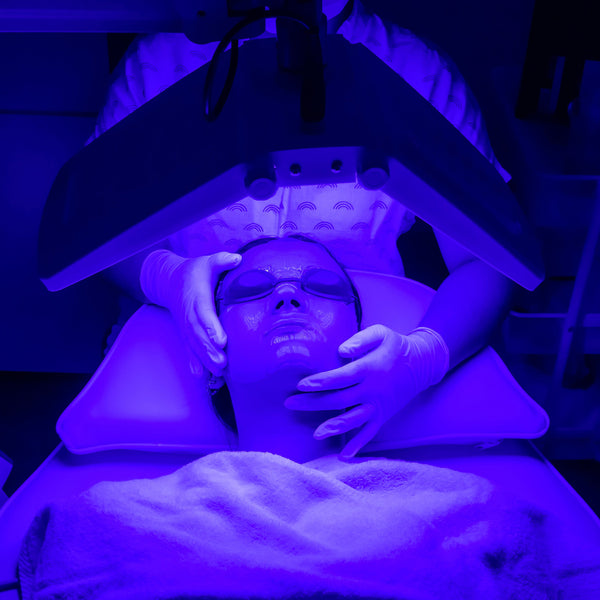Addressing Accessibility in Spas: Designing Safe Spaces for Everyone

When I started working on the article on accessibility for SkinDeep Magazine, my first instinct was not only to educate and provide insight into a problem that doesn’t seem evident at first glance but also to do it from another person’s perspective. Not only did I learn a great deal myself in the process, but I created a genuine connection with an incredible esthetician - I had the pleasure of interviewing an industry peer who has been thriving as an esthetician, brand owner, and educator for over ten years. I was introduced to Leigh Wick by a close friend of mine and a renowned esthetic educator and consultant, Richard Merrill when I shared with Richard that I was writing a piece about accessibility and inclusivity in the spa. During our interview, I learned a lot about Leigh’s life and her success story in the beauty industry. She not only shared her knowledge on accessibility in the spa from the licensed esthetician’s perspective but, most importantly, from the perspective of a person in a wheelchair. We spoke about essential accessibility aspects, such as designing the spa space for easy access and inclusivity, as well as curating marketing materials and websites for hearing-impaired and vision-impaired clients.
Leigh was born with lumbar Sacral Agenesis, a highly rare genetic birth defect, at a time when the world was not yet accessible – 53 years ago. Sacral agenesis is an extremely rare condition that affects how the lower part of the body develops in the womb. The sacrum is formed by five vertebrae that are joined together, and babies with sacral agenesis are born with part or all of their sacrum missing. Leigh was the first child to have undergone a groundbreaking surgery where her legs were amputated, and the bones were used to reconstruct her spine so that she wasn't sitting on all of her major organs. She spent the majority of her early childhood in and out of surgeries and was in the hospital until about the age of four. Altogether, Leigh braved through 14 surgeries between birth and four years old. She was the March of Dimes poster child for five years and still remembers vividly all the times she was applauded as a child and seeing her face on big slideshows. When we spoke, Leigh teared up thinking back to those memories, she said that even at that tender age, she already knew she had an intrinsic purpose, a purpose to show the world that she can.
“I always had that innate sort of knowledge in me, and I always was able to sort of feel ways that I could lift other people up just from getting their sense of what was insecure for them and what was not.”
Leigh’s career in the beauty industry started over 20 years ago when she took on a part-time job at MAC as a makeup artist while still working as a paralegal, a career she had held for a long time and was excelling at. MAC was the place everyone would come to learn how to apply makeup from the pros, in the early days, before YouTube tutorials and social media.
“I really felt that was my purpose - I was very confident. I wasn't trying to be a poster child anymore, I was just a regular makeup artist who was hot, who happened to be in a wheelchair.”
At that time, twenty years ago, Leigh didn’t even know what an esthetician was, but she knew she loved giving her clients a natural, dewy look, something that wasn’t necessarily “in” in the early 2000s. Her friend recognized Leigh’s talent and suggested she attend esthetician school to gain more knowledge of skin and a career in esthetics. She was still working as a paralegal in 2016 when she embarked on her journey at Paul Mitchell, to becoming a skin care professional. Since then, she has not only been a six-figure esthetician in her own practice, Vanity Makeup and Spa, but has created her own successful skincare line – Matusa and has been a mentor and a recognized face in our industry.
I asked Leigh to help me pen this article from not only the perspective of an esthetician who is constantly trying to improve upon the client experience but also from the perspective of a person who uses a wheelchair.
Leigh mentioned that she uses a manual wheelchair that needs ample room to turn around, and oftentimes, esthetician rooms are too small and crowded with equipment to allow her to get in and out freely. In addition to that, she noted that the product displays and counters are often too high for her to reach, as she is sitting down in a wheelchair.
“If your aisles are too small, or if your business is too cramped with a lot of inventory, a simple phrase, “I know we’re a little crowded in here, so let me know what I can show you, and I will bring it to you. I will be your personal shopper while you are here, and we can take as long as you need.””
Every business owner in 2023 should assume that there will be patrons who frequent their establishment with various needs that require accommodation. There is not a “one size fits all” accessibility model for accommodating differently abled clients in the esthetic business. Disabilities are unique, just like all people are unique, and some people in wheelchairs have more mobility than others. Everyone’s reach is different, their ability to transfer to a chair is different, their height is different when they are sitting, their neck mobility is different, the use of their limbs is different, and the sizes of their wheelchairs are different.
As soon as the consumer presents as disabled or discloses a disability along with a desire to book treatments at an esthetic business, they should be asked what accessibility points are crucial for them to be comfortable, as accessibility is often subjective. It is less evident than a ramp or an elevator - it may be curb-side pick-up or visual consults. It may be performing a haircut with the client in a wheelchair. It is often a “make it work” attitude that will determine whether the client will come back as a repeat customer or whether he or she will leave, being offended at the lack of accommodation.
“Communication is the most important aspect of developing a personable and long-lasting relationship with patrons. It’s common sense that the longer the client is retained in any business, the more money he or she will spend in that business. This is true in the beauty industry, and not many beauty or wellness businesses speak to disabled consumers, even though their beauty dollar spends the same. The beauty industry has ignored the conversation regarding accessibility, even though it is a law and is a conversation that has been long overdue. Because the conversation around inclusion in the beauty industry is ignored, potential clients are ignored. Their money is left unspent in the economy, and disabled consumers are excluded due to a lack of overall awareness regarding inclusion and accessibility. Being a solo business owner leasing in a salon does not remove you from being sought after by disabled clients. You need a plan.”
Leigh’s advice for the business owner is to ask the consumer to disclose any accommodations that need to be made immediately on the sales floor or in the treatment room. The question itself portrays an awareness and an openness regarding the situation, which the disabled patron will find extremely trustworthy. This means that the business owner recognizes and respects the need for accommodation to value the patron’s business. Respect is crucial in establishing a relationship between a business owner and a customer – the disabled customer isn’t going to demand a ramp be built on the spot, but he will feel seen, heard, and acknowledged.
If the potential client calls on the phone and wants to book a facial - ask him or her if they have any disabilities that require the use of mobility devices, or if they have any hearing or visual impairments that you should be aware of to make their arrival as welcoming as possible. This also allows you to rearrange furniture to accommodate a wheelchair or allows you to set up for a “chair service” so the guests may remain in their wheelchair, or it allows you to prepare your front desk staff for any additional support that may be needed. Have your intake paperwork include accessibility issues, and if you need to, call the client after reviewing the intake paperwork so you can work out any issues prior to their appointment. Up-front communication can make the process immediately positive or negative for a disabled consumer and set the tone for the remainder of the relationship.
The Americans with Disabilities Act (ADA) is a federal civil rights law that prohibits discrimination against people with disabilities in everyday activities. The ADA guarantees that people with disabilities have the same opportunities as everyone else to enjoy employment opportunities, purchase goods and services, and participate in state and local government programs. According to the information posted on the ADA website, many businesses can and do put themselves out there as adversaries by not even appearing to make a business accessible, which may infuriate disabled patrons and create liability. Business owners should be aware of the laws in their state and county and have an accessibility plan regarding their specific business location. There is a legal difference between saying:
“My business is up a small flight of stairs, and due to the age of our building, we don’t have an elevator. However, if you don’t have mobility to get up the stairs, I have an accommodation plan in place for customers in wheelchairs. I value your business, and I’m happy to go over your options now so I can serve you in a unique way.” and “We don’t have an elevator. I’m sorry.”
The first business has an accessibility plan for people in wheelchairs that could include a video system where the customer calls the business owner from the base of the stairs. The shopping is done virtually, and the business delivers the goods to the bottom of the stairs so the customer is happy, feels valued, and leaves that business with a positive feeling and with money spent. Adversely, the second business has lost a transaction forever, and the disabled customer may spread the business name on various websites and Facebook groups regarding consumer accessibility as a negative experience.
-
Know your doorframe size
Knowing the doorframe size will tell you whether a person in a wheelchair will fit through the door. There is no uniform standard for wheelchair dimensions, but the typical wheelchair is around 36 inches tall, 25 inches wide, and 32 inches long. It is recommended by the ADA that you have a minimum of 32 inches for door openings. However, for most people, a door with a 30-inch opening is more than enough for standard wheelchair access. If the door opening is smaller than the standard size, think of ways to service the client outside the door, or think of ways to safely get him or her through the threshold. Remember, ask the client what they think is a reasonable accommodation. They’ve lived with their own disability. They know what needs to be done for them to participate, and it’s usually very simple. Ask the person in the wheelchair to measure their chair from wheel to wheel in width.
- Have a transfer plan
- Restrooms
- Reception area
- Online accessibility
Leigh believes that it is ultimately the consumers’ responsibility to advocate for themselves regarding how they operate in the beauty industry. They need to be able to effectively communicate what they need regarding accessibility, as they are the only ones who know what their own bodies are capable of. The consumer can and should tell the esthetician or front desk receptionist what they need to become a loyal customer.
The biggest takeaway from my interview with Leigh definitely remains humility, and a willingness to make accommodations for all customers who seek treatments from a spa. Most estheticians go into the profession because they want to instill confidence in clients and make them feel beautiful – this was my reason for getting my license 17 years ago. I hope these tips will inspire all readers to examine their offerings and space layout and see if there are any missing pieces in the accessibility puzzle they still need to improve upon.










